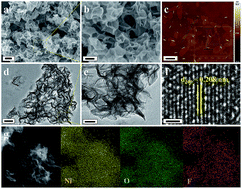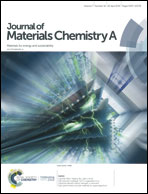Ultrathin mesoporous F-doped α-Ni(OH)2 nanosheets as an efficient electrode material for water splitting and supercapacitors†
Abstract
Two-dimensional (2D) nanomaterials with a high specific surface area and mesoporous nature are attractive and have wide applications in catalysis, energy storage systems, etc. Here, we report a novel strategy to fabricate noble metal-free, F-doped α-Ni(OH)2 mesoporous 2D ultrathin nanosheets. The F-doped α-Ni(OH)2 nanosheets exhibit remarkable electrocatalytic activity and stability for the oxygen evolution reaction, achieving a low onset potential (260 mV), high mass activity (69.1 A g−1 at η = 350 mV) and low Tafel slope (31.89 mV dec−1), which are superior to those of commercial RuO2 catalysts. Simultaneously, F-doped α-Ni(OH)2 nanosheets are found to have a high specific capacitance of 158.75 F g−1 at 1 A g−1 with a maximum energy density of 67.4 W h kg−1 at a power density of 400 W kg−1, which could still retain 40 W h kg−1 at a power density of 16 kW kg−1. DFT calculations rationalize that F doped α-Ni(OH)2 favors electrical conductivity, efficient electron transport and water adsorption. It could be envisioned that the proposed simple and efficient approach will pave a new way to synthesize other anion doped 2D materials for energy conversion and storage technology.



 Please wait while we load your content...
Please wait while we load your content...